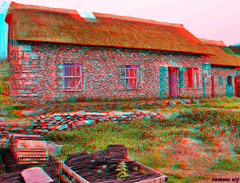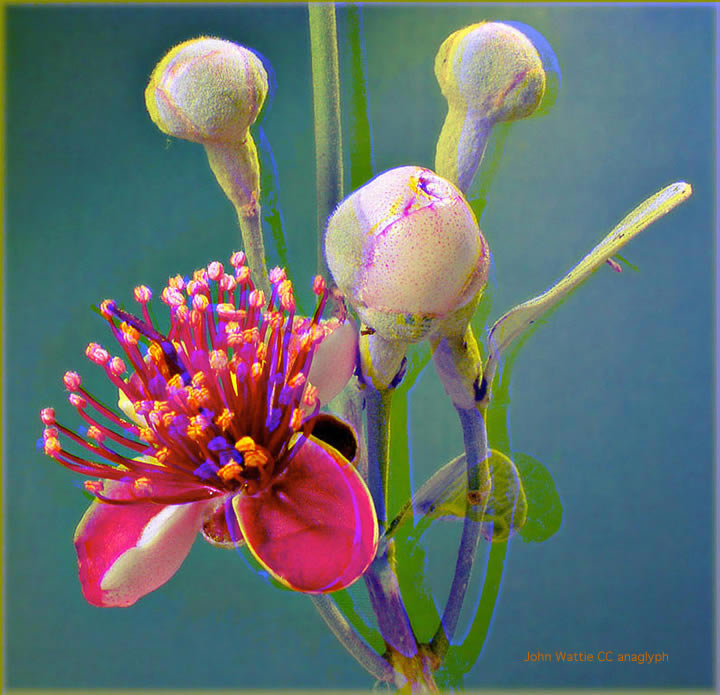Yellow / Blue (ColorCode©)
Anaglyph links: Red/Cyan 
How to make red/cyan anaglyphs
Optimised anaglyphs
Flickr Anaglyphs Discussion Wimmer algorithm The "blue penguin" experiment
Anaglyph making for printing on paper
Printed anaglyphs are often full of ghosts. David has done many experiments which explore how to convert RGB anaglyphs to ghost-free, CMYK, printed anaglyphs. Highly recommended.
Anachrome selected links
http://www.anachrome.com/wadir.htm
Alan Silliphant has chosen his favourite anaglyph sites (to be seen with his Anachrome glasses, of course!)
http://www.flickr.com/photos/34437703@N00/
Alan's anaglyphs
Flickr
There are numerous groups showing anaglyph 3D, do a search.
My 20 favourites from Flickr (favourites change!)
Art works converted from 2D to 3D
The Italian master at converting beautiful paintings or photographs into outstanding anaglyphs and stereo pairs. He has written his own software. The results can be even better than direct stereo photographs, making this a "must see" web site.
Small-size sample of a Guglielmo Menagatti 2d-3d conversion. He delights in making 3D look like "real" 2d when seen without the anaglyph goggles, but this, despite its beauty, is not one of those! The "floating window" technique was perfected and included in the Gugle software.
Click to reach the original, and others.
Flickr 2D to 3D Conversions from around the world.
French Alps by Pierre Gidon
This is one of the classical stereo web sites, showing the beautiful French Alps. The French version of English is delightful. Make sure you set the pictures for large, if your screen is big enough. You gain a lot of 3D and resolution but lose nothing. Even the little images are coming as large, but reduced in size on your browser. Stereo parallax is reduced on small images, just as all the other dimensions are smaller.
Mountains and fields have very little red in them, so anaglyph colours work well. However, ghosts are often severe, especially where dark rocks are seen beside white clouds or snow. The vast scenery has been captured by hyper-stereoscopy, as it should be, so there is lots of 3D depth, better than much of the US Geological Survey web site (which is linked below). Often the window effect is wrong because distant mountains are in register, which can be a little disturbing in the for-ground, but has the huge advantage of reducing ghosts. Sometimes for-ground objects show in one of the pairs and not the other, which is a great crime in stereo circles, but I for one am willing to forgive him.
How to get correct stereo window, which Pierre Gidon does not always achieve, is very well illustrated by Shahrokh Dabiri
3D images by dr. Imre Zsolnai-Nagy, Hungary
Imre is very innovative and has made macro 3D images using many methods, but the twin Canon 300D rig using a half silvered mirror (as described by John Hart) probably produces his best quality. Imre's modification of a Lens In A Cap for stereo macro is his own invention.
Imre's site has the LIAC sections running on Masuji Suto's stereo viewer, written in Java. This is faster and more versatile than John Hart's excellent viewing program written in Perl, but Bill Gates has messed about with Java. People running Windows sometimes download true Java for Masuji's applet to give reliable performance. As you might expect, Masuji's program always runs perfectly on a Macintosh and is a great way to rapidly check how images look in various versions of anaglyph.
http://imre3d.axo.hu/macro_web/macro.htm
Insects, taken with Spanish Precision, by Paul Weissbach
http://home.fotocommunity.de/phw
Superb anaglyph quality and outstanding 3D of these small, active critters.
Microscopy of the fly and other insects in 3D
http://www1.tip.nl/~t936927/home.html
Wim Van Egmond's amazing stereo microscopy, anaglyph format.
Anaglyphs by Louis Carlsson
http://www.carlsson3d.com/index.html
Danish photographer with stimulating new ideas. Check out his panoramas of Copenhagen.
Anaglyphs by Dmytro Bezsmertnyy
http://tridimka.fotoplenka.ru/
Russian Language site showing many high quality anaglyphs.
Anaglyphs by Wojtek Rychlik
http://pikespeakphoto.com/anaglyphs.html
Photographer based in Colorado but showing 3D pictures from Europe as well. Check out his hyperstereoscopy of mountains, but click on the titles for anaglyphs, (not his thumbnails, which link to 2D images and anaglyphic frustration! )
Moscow in hyperstereo anaglyphs and stereo panoramas by Sergio Elizaroff
http://www.flickr.com/photos/44405149@N00/
http://www.deep-life.ru/phototeka/spb-6/index.htm
Moon
http://www.nasm.si.edu/events/apollo30th/moontheater/anaglyph.html
NASA images in anaglyph
Stereo "eye candy"
Some fancy images in 3D anaglyph - "New Age Art Form"
United States National Parks
http://3dparks.wr.usgs.gov/carlsbad/html/thumbs.htm
Warning: big files, you really need broad-band. Many of the huge number of historical monochrome images on this US Geological Survey site are better 3D than recent colour images, which often have precious little 3D because small stereo cameras have been used on vast scenes. For big landscapes it is necessary to use hyper-stereoscopy as in the French alps above. However, this cave section does have good 3D, although poor mounting for stereo window. Often anaglyphs are mounted "incorrectly" on purpose so that the main part of the scene is in register, which makes the colour more realistic when viewed without the red/cyan goggles and more important, reduces ghosting.
Mars
http://www.marsunearthed.com/Anaglyphs/BestOf_AnaglyphIndex_files/Best_of.htm
The geological details of Mars are better appreciated in stereo than on flat images and there are many 3D anaglyphs to peruse here.
Terry Wilson has converted some of these to phantograms.
Japanese 3D, by Kawagoe
http://www2c.airnet.ne.jp/kawa/index_e.htm
Includes red/blue anaglyphs (red/cyan glasses will work). Many window violations (WV) - even the experts often get this wrong.
Various anaglyphs
http://www.eyetricks.com/anaglyphs/
History of anaglyphs, especially movies and comic books
http://www.ray3dzone.com/ana.html
John Wattie anaglyphs
The back-ground image is a small red/cyan anaglyph of a puff-ball fungus.
 A "Famine Cottage" Dingle Peninsula, Ireland
A "Famine Cottage" Dingle Peninsula, Ireland
Red/cyan anaglyph by John Wattie. Click for a bigger version.
Stereoscopic sun in anaglyph format
ColorCode Anaglyphs 
Other Colorcode web sites previously linked from here have died. Several external sites are still available from the above official site. Also try Flickr:
http://www.flickr.com/photos/colorcode3d/sets/72157602099838928/
"The battle of the anaglyphs"
A ColorCode versus Red/Cyan "battle" was organised by Louis Carlsson (Denmark) to see how different anaglyph experts handle the challenging image shown below in CC format.
Red/Cyan (The RC image labeled "Wattie" was actually by Wojtek Rychlik. Software used by the "gladiators" was not recorded, but Wojtek is known to favour anabuilder.) Note the RC version by B. Allen is almost perfect colour, in Proview or Anachrome (Mirachrome) goggles, which leak red through the cyan filter. With American Paper Optics goggles, even B. Allen's version fails (because APO cyan filters do not leak red.)
ColorCode (Photographer Labels for CC images are correct. 3Dimka is the code name for Dmytro Bezsmertnyy. "Official ColorCode" was the only image made with ColorCode software, at the default settings. All others were made in Photoshop.)

The original macro stereo image was by John Wattie. This picture is a ColorCode anaglyph (CC) made by John Wattie in Photoshop (not in the commercial ColorCode software). The blue channel has been lightened to reduce the darkness of the right eye which some people find disturbing with ColorCode. As explained previously, the 3D image is improved for old viewers with presbyopia if a -0.7 diopter lens is used over the right eye, in addition to the Colorcode goggles and any reading glasses you may need to see computer images.
NB: This anaglyph will NOT work with red/cyan goggles, only Amber/Blue gives 3D. 
Archives of Anaglyphs Yahoo group
Etienne Monneret of anabuilder program has the archives running on a computer under his bed as a generous free service to the stereoscopic community. A link from there will enable you to join the discussion, if you register with Yahoo.


